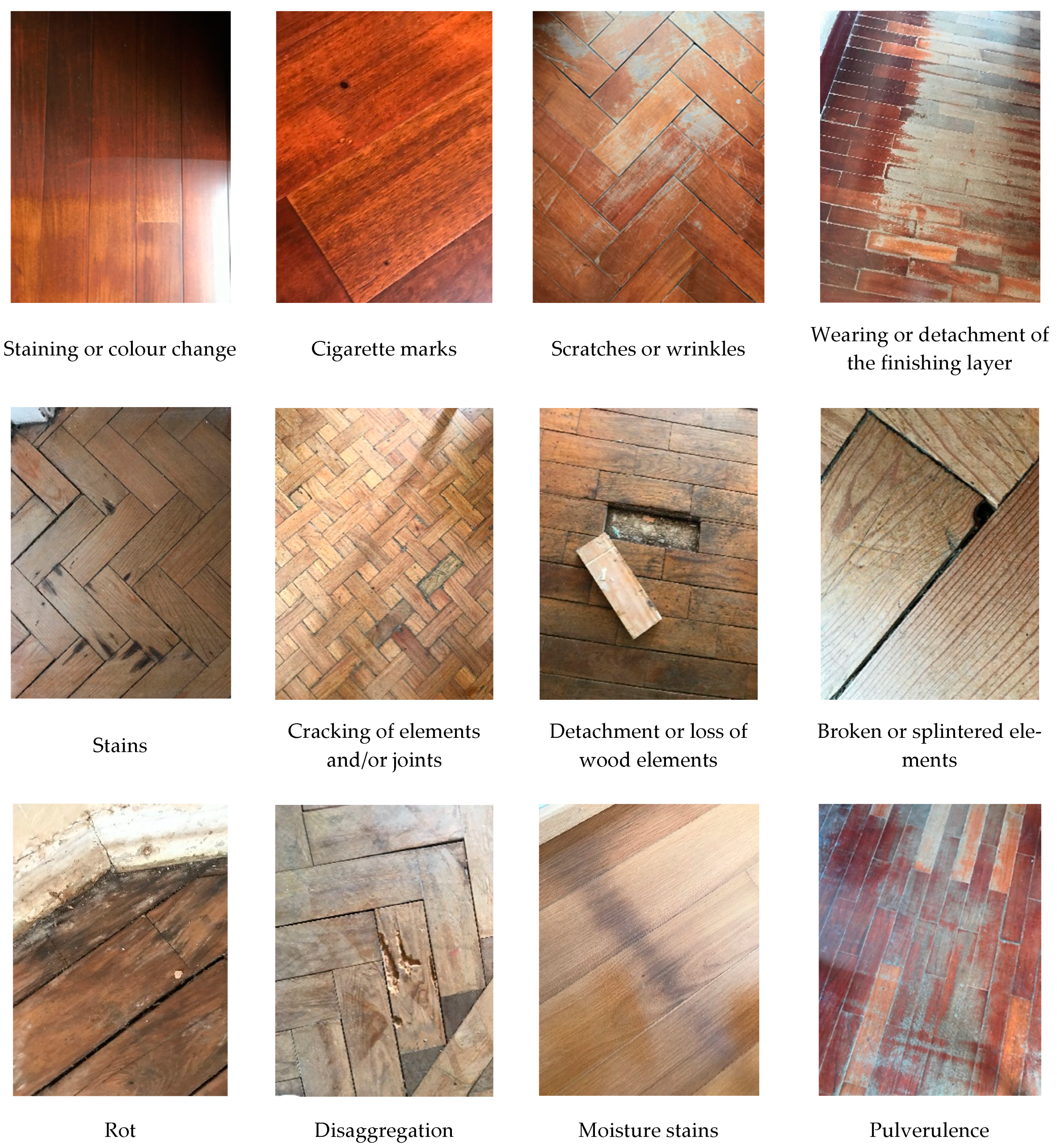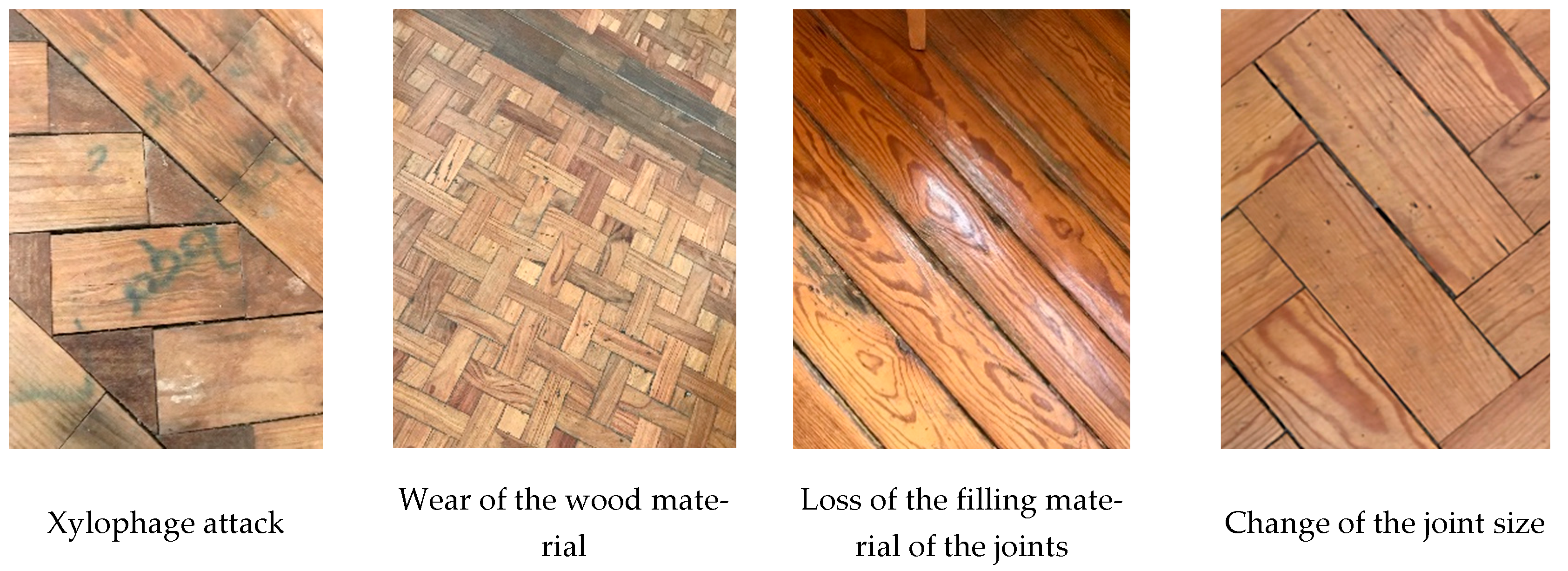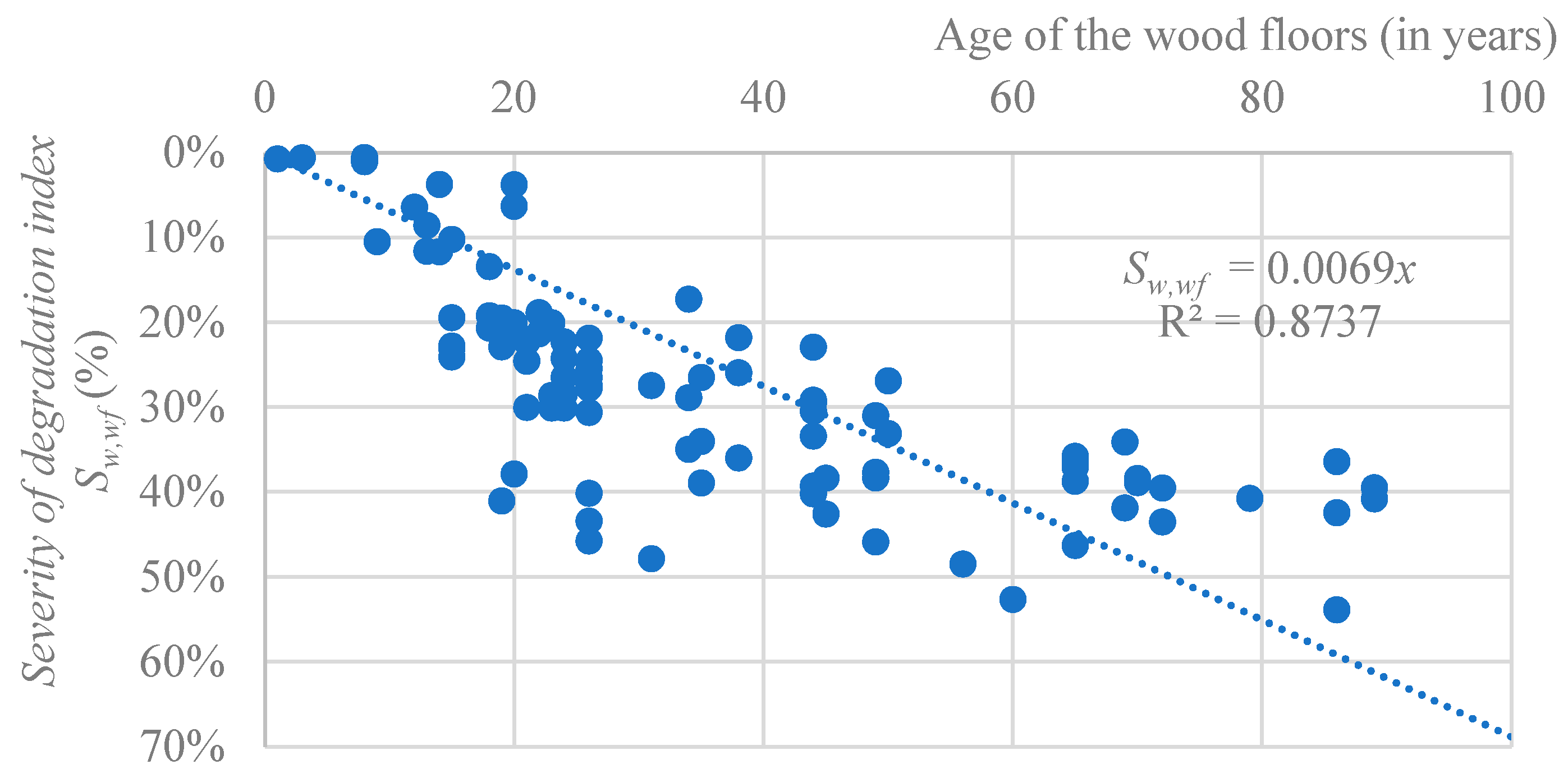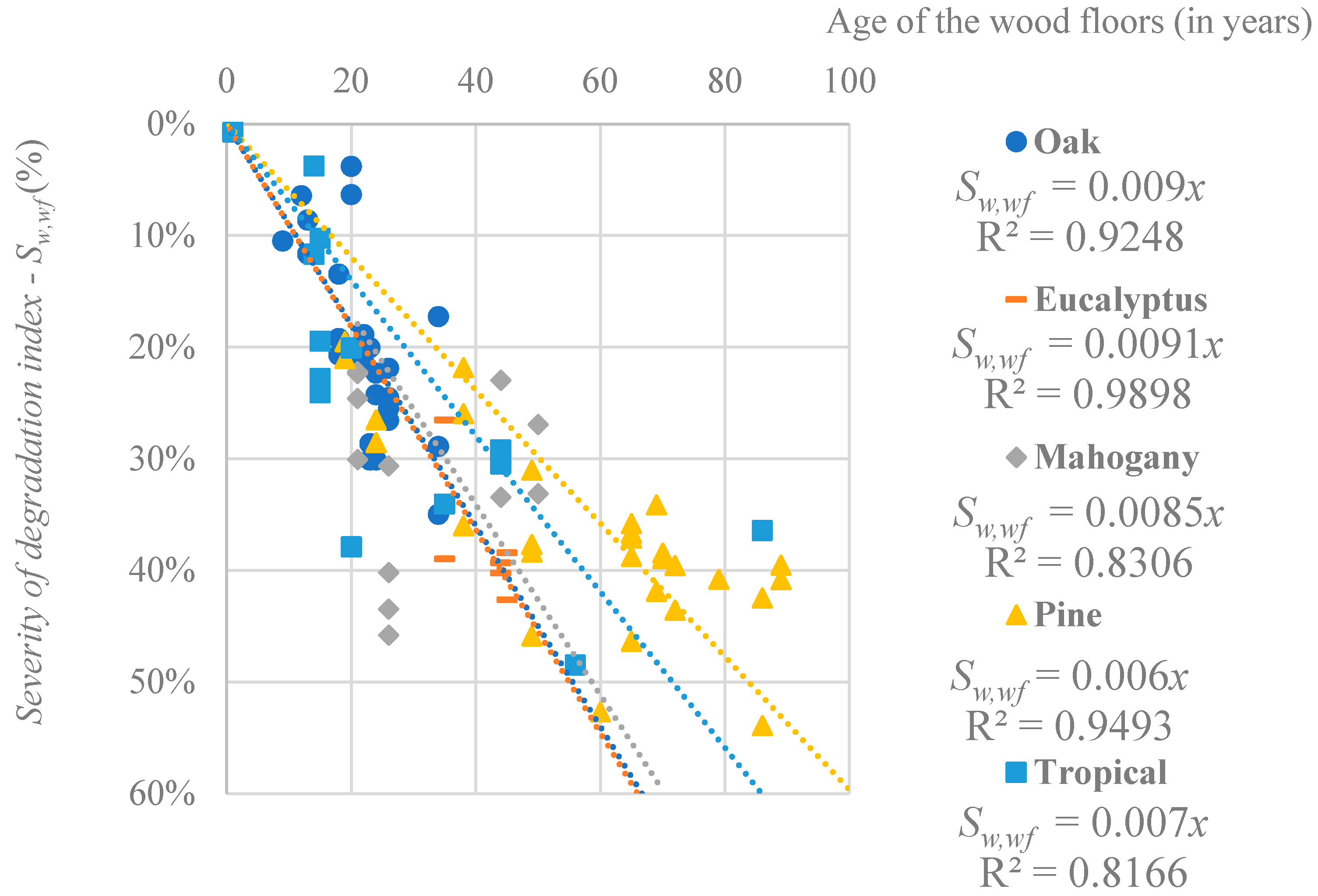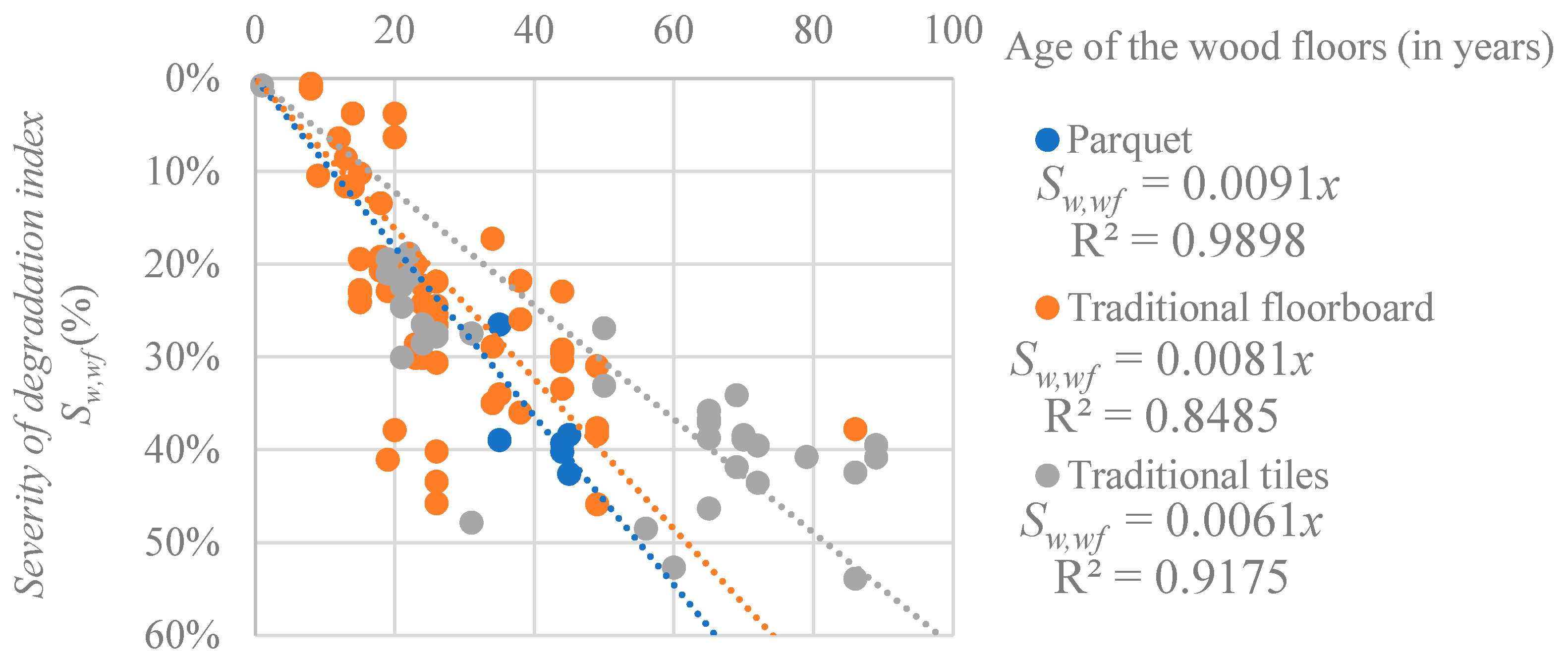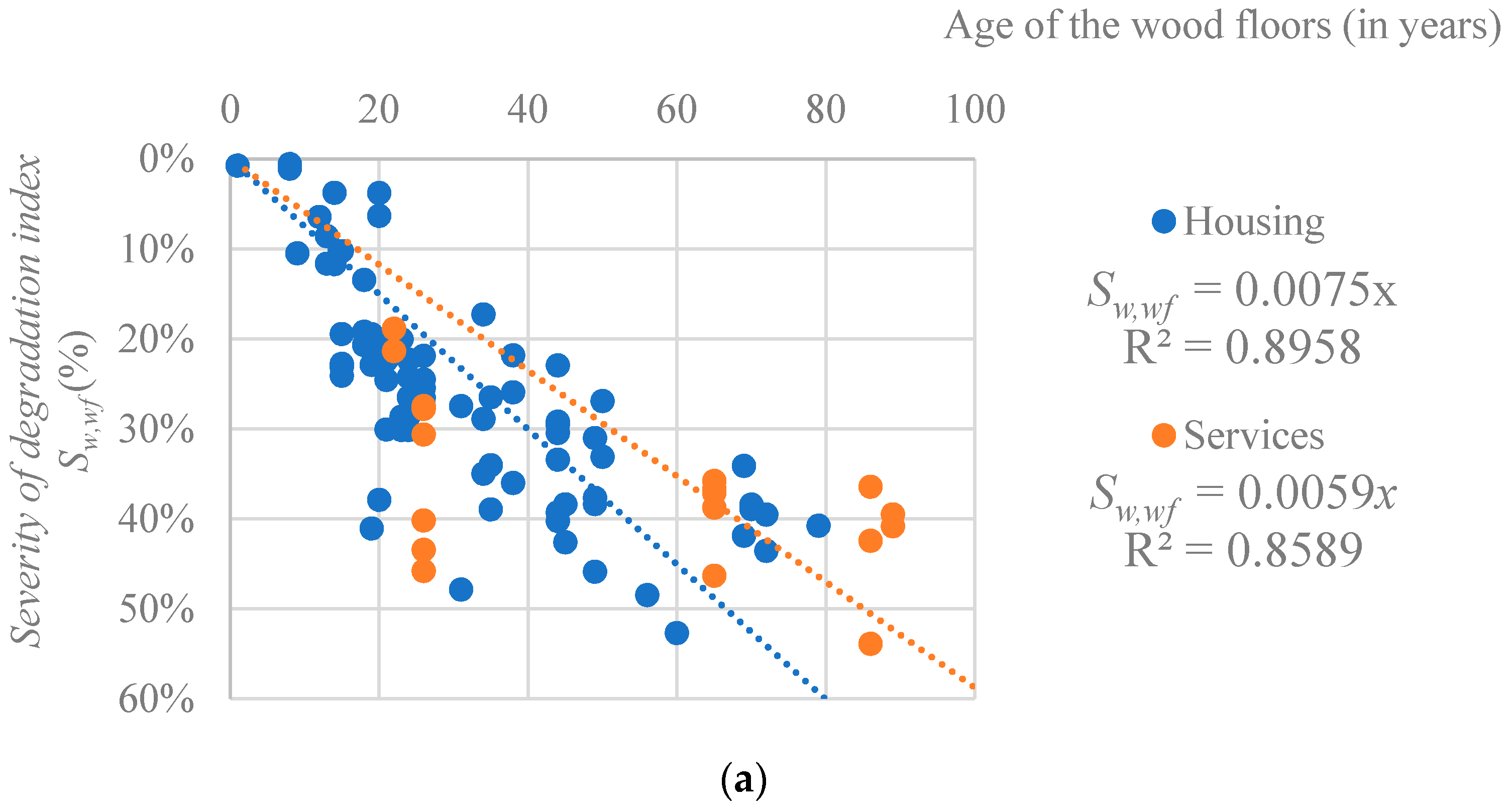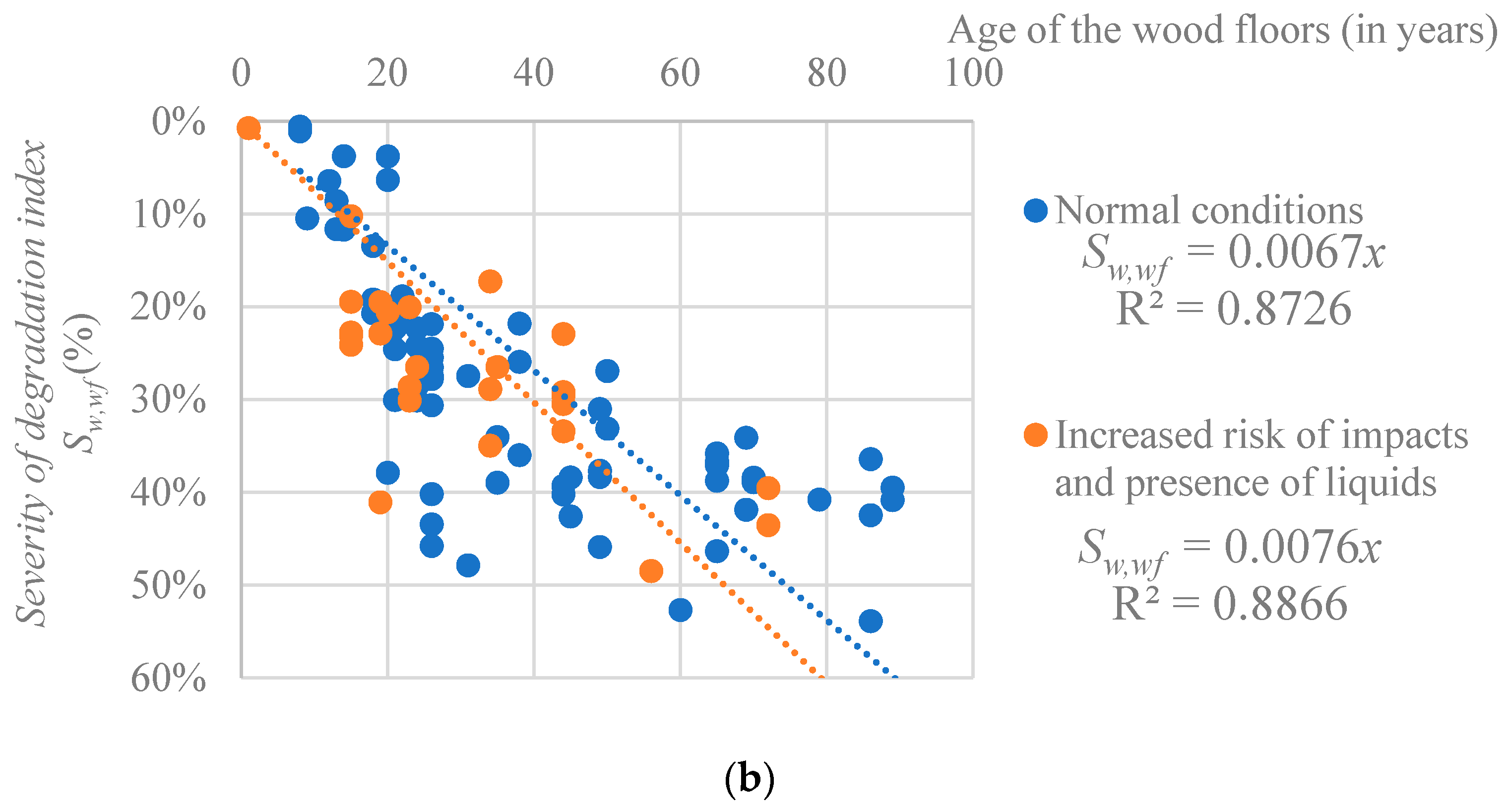3.1. Definition of a Degradation Curve for Wood Flooring Systems
In this study, and through the adoption of the proposed model, the evolution of the degradation condition of wood floorings over time can be characterised by a degradation curve. This curve (
Figure 2) is a graphical representation of the evolution of the degradation condition of wood floorings over time, and is obtained through a regression analysis between the numerical index that expresses the degradation of wood floorings (
Sw,wf) and their age, considering the sample analysed in the fieldwork survey. The regression model is used to evaluate the variability of
y (i.e., the severity of degradation index) that varies with the variability of
x (i.e., the age of the wood floors) [
16], or in other words, the regression analysis allows identifying the percentage of the variability of the severity of degradation of wood floors that are explained by their age.
In this study, a linear degradation pattern is adopted to describe the degradation of the sample analysed (97 wood floorings). According to various authors [
20,
21,
22,
23], a linear degradation pattern is adequate and valid to describe the degradation of interior components, in standard service conditions. This pattern describes a time-dependent linear degradation of wood floorings, which are subjected to consistent and continuous degradation agents over their service life, especially, when the floorings’ users are the same throughout their lifetime, adopting consistent conditions of use and maintenance. Moreover, the climatic degradation agents (e.g., UV radiation, humidity, and temperature) acting on the interior floors are less aggressive and less variable (e.g., interior floors are not subjected to rainfall and direct solar radiation, whose intensity varies over the year, as well as during the day) than the agents acting on the external claddings [
24].
The estimated service life of the wood flooring systems can thus be determined based on this overall degradation curve, through the intersection between the degradation curve and the theoretical limit adopted to establish the end of service life of this component. As mentioned in various studies [
16,
25], the end of service life is a conventional limit that it is not easy to specify, which relies on subjective criteria as the users demands and expectations, the funds available for maintenance actions, among other parameters, are difficult to model.
Figure 3 shows different examples of three levels of severity of degradation of wood floorings, revealing that a flooring with a severity of degradation of 20% still presents an adequate condition level, and therefore, adopting a maximum severity of degradation of 20% seems excessively conservative to establish the end of service life of wood flooring systems. Conversely, a floor with a severity of degradation of 40% already shows clear signs of generalised deterioration, and the presence of some anomalies that compromise the floors’ functionality. In this sense, a limit of 40% for the severity of degradation, to establish the end of service life, seems too high and inadequate to fulfil the users’ demands. Therefore, in this study, it is assumed that a severity of degradation of 30% corresponds to the end of service life of a wood flooring.
Having established this limit, the estimated service life of the wood flooring systems can be obtained graphically; for the sample analysed and based on the overall degradation curve defined in
Figure 2, an estimated service life of 44 years is obtained, which is in accordance with the literature and empirical knowledge about the durability of these elements. According to the existing literature on the durability of wood flooring systems, the service life of these floors can vary significantly. Nebel et al. [
26] obtained an estimated service life of 10 years for multilayer parquet, while Seiders et al. [
27] state that a floor can last up to 100 years, with a service life similar to the building’s. Anderson et al. [
28] obtained an estimated service life of 20 years for multilayer parquet glued to the substrate. Nebel et al. [
26], for 8 mm parquet and 10 mm parquet, obtained an estimated service life of 25 years. Jönsson et al. [
29] and Jönsson [
30] estimated a service life of 40 years for pine flooring. Scharai-Rad and Welling [
31] and Petersen and Solberg [
32] suggested a service life of 45 years for oak flooring, while Eaton and Hale [
33] and Asdrubali et al. [
34] state that oak woods present an estimated service life ranging between 35 and 50 years. Adalberth [
35] and Mithraratne and Vale [
36] obtained an estimated service life of 50 years, for 22 mm parquet. Gunther and Langowski [
37] obtained an estimated service life of more than 50 years for parquet. Aktas and Bilec [
38] concluded, with an 80% confidence interval, that the service life of a wooden housing floor is, on average, 40 years. This confidence interval was defined in accordance with ISO 15686-1 [
39], to define minimum and maximum limits for the variance of the results of the estimated service life, with a minimum of 15 years and a maximum of 73 years.
3.2. Influence of the Characteristics of Wood Flooring Systems on Their Service Life
The dispersion of values proposed in the literature for the expected service life of wood flooring systems reveals that the wide range of characteristics of wood floorings strongly influences their behaviour over time, affecting their durability. Reinprecht [
40] refers that the service life of wood elements depends essentially on the natural durability of the wood, but also varies considerably according to the design characteristics, the protection applied, and the exposure and maintenance conditions. In this sense, the evolution of the degradation condition of wood floorings should also be analysed as a function of the different characteristics of these floors.
In this study, different curves are proposed according to the relevant characteristics of the wood floorings analysed. The type of wood is the first characteristic analysed, and five categories are considered to typify the sample analysed: (i) oak; (ii) eucalyptus; (iii) mahogany; (iv) pine; and (v) tropical woods (e.g.,
Couratari oblongifolia,
Dipteryx odorata and
Diplotropis sp.). In the sample analysed (
Figure 4), oak and eucalyptus wood floorings present the lower estimated service lives, around 33 years, followed by mahogany floors, with an estimated service life of 35 years, and by tropical woods, with an estimated service life of 43 years, and, finally, by pine wood floorings, with an estimated service life of 50 years.
Various studies [
41,
42] emphasise the crucial role of the natural durability of the wood species on the service life of a wood flooring. The results obtained may seem incongruous with the empirical perception regarding the durability of wood species. Usually, pine is considered as a less durable type of wood and non-resistant to decay due to xylophage attack [
43,
44]. However, as a natural material, the physical properties of a wood element vary significantly, even within the same wood species [
45]. Cruz et al. [
46] refer that, usually, the wood species are divided into softwood (e.g., pine) and hardwood (e.g., oak, eucalyptus, and some tropical species) and among hardwood species, the properties of wood range between not very resistant nor durable to very resistant and durable woods (as some Brazilian species, as the ones included in the category “tropical” analysed in the present study).
Therefore, the results reveal three major conclusions (the sample analysed is relatively small, so the results should be analysed with some caution): (i) oak, eucalyptus and mahogany species present similar degradation curves, revealing lower estimated service lives than tropical or pine wood floorings; (ii) tropical floors are usually more durable, since more naturally durable wood species have been applied while greater care was taken at the time of execution given the specificity of the material, and greater attention is taken in the floors’ maintenance; and, (iii) the main reason why pine floors are more durable, within the sample analysed, is because 75% of the pine floors inspected are traditional tiles, which have a significant thickness, and whose maintenance implies polishing and applying wax, as a protective layer, weekly or monthly, thus mitigating anomalies that may occur over the service life of the floor.
In this sense, while the quality of the wood used is undoubtedly relevant to the service life of wood flooring systems, correct design also plays an important role [
34]. In the sample analysed, three types of floor solutions are analysed [
47,
48,
49]: (i) parquet, consisting of a set of wooden slats, with a total thickness around 8 mm; (ii) traditional floorboard, entailing several wooden strips that can be solid or laminated, with a thickness between 18 and 20 mm; and (iii) traditional tiles of solid wood, with a thickness between 17 and 22 mm. The degradation curve obtained according to the type of floor (
Figure 5) reveal that parquet floors are the less durable of the sample analysed, with an estimated service life of 33 years, followed by traditional floorboard, with an estimated service life of 37 years, and by traditional tiles, with an estimated service life of 49 years. The thickness of the wood elements seems to play an important role in the durability of the wood floorings; naturally, thicker floorings, have longer estimated service lives, in addition to allowing more intrusive maintenance actions, which allow extending the service life of the elements in more adequate conditions of use.
Other intrinsic characteristics of wood may also be analysed, as its hardness, which is a relevant property for the selection of a given wood used in flooring indoors [
50,
51]. The hardness of the wood elements is intrinsically related with their density, which depends on several factors, such as the tree species and growing conditions, which are variable in the same species and in the same tree [
3]. In this sense, the sample analysed was divided into two categories: (i) softwood species, which usually present lower densities [
3]; and (ii) hardwoods, usually more resistant to impacts, scratches, and wear [
52,
53]. Due to the multiplicity of characteristics that influence the hardness and density of a wood species, it is not possible to draw unequivocal conclusions regarding the impact of this characteristic in the service life of wood flooring, but
Figure 6 presents some statistical analysis regarding the influence of the wood’s hardness in the presence of related anomalies, revealing that hardwood floorings are less prone to suffer scratches, wrinkles, and wear of the wood material.
The type of surface coating of the wood floorings is also a relevant parameter to protect the floors from liquid water and direct UV radiation, avoiding anomalies that compromise the natural and aesthetic characteristics of the wood floorings, while increasing the service life of these floors [
54]. Concerning the type of coating of the wood floorings, three types of protection treatments are analysed: (i) oil-based matte finishes; (ii) wax; and (iii) varnish.
Figure 7 shows the degradation curves obtained for the sample under analysis, according to the surface coating. The sample corresponding to the oil-based matte finishes is small (7 case studies) and the older case study has 26 years, and therefore, no unequivocal conclusions can be drawn regarding the influence of this coating on the service life of wood floorings. The varnish coatings present a lower estimated service life (around 38 years), when compared with wood floorings with a wax coating (with an estimated service life around 52 years).
Richardson [
55] states that varnish can be an attractive solution to protect wood applied in interiors, but almost all varnishes suffer from a preferential wetting failure due to the fact that varnish is hydrophobic, and wood is hydrophilic, and in the presence of water, the interaction between the two materials may privilege the deterioration of the wood elements. Moreover, when exposed to the direct incidence of UV radiation, varnishes tend to oxidize and become opaque. Specifically, varnish degrades over time, and its efficiency is limited in time, losing elasticity, and becoming brittle, thus making the wood susceptible to various agents of deterioration. Unlike varnish, which is usually applied as a protective film, wax is usually impregnated in the wood [
56], with generally longer periods of action, increasing the dimensional stability of the wood floorings exposed to moisture [
57], and promoting a more homogeneous and regular degradation of the wood floorings over time. Furthermore, in Portugal, wood floorings with wax coatings tend to be maintained more regularly, with the removal of old wax and application of a new layer of wax.
The installation of wood floorings in contact with moisture or near moisture sources is seen as a risk factor that promotes the deterioration of these flooring systems [
19,
58]. Various studies [
18,
59,
60] identify the presence of moisture as one of the main causes of anomalies in wood used as coating material.
Figure 8 presents the degradation curve of wood floorings according to the exposure to moisture sources (e.g., sanitary facilities, kitchens). In the sample analysed, a wood flooring near to moisture sources has a 70% probability of presenting some anomaly related to the presence of water (e.g., moisture stains, rot, cracking). The results obtained confirm the that a wood flooring near or exposed to moisture sources reaches the end of its service life sooner (after 38 years) than a flooring protected from moisture sources, which only reaches the end of its service life after 45 years.
The degradation of wood floorings also occurs due to the action of mechanical or some chemical actions [
46]. In the sample analysed, the case studies are not subjected to chemical degradation agents and, therefore, this degradation mechanism is not considered. On the other hand, the use conditions influence the degradation of the wood floorings analysed.
Figure 9 shows two degradation curves according to the type of use and to the in-use conditions. First, the analysis of the type of use reveals that wood floorings in services buildings present a higher estimated service life (around 51 years) than floors in housing (with an estimated service life around 40 years). This result reveals that, even though the floorings in services buildings are more exposed to an intense circulation and use, a more frequent and careful maintenance increases their estimated service life.
Moreover, in housing, some case studies are exposed to the presence of pets, children and some are used to have meals, which increases the risk of impacts and presence of liquids. When this risk is analysed, as in
Figure 9b, an increased risk of impacts and presence of liquids leads to a lower estimated service life (around 39 years) than floors in normal in-use conditions (with an estimated service life of 45 years). A more detailed analysis is performed, evaluating the differences in the expected service life of wood floorings according to the house room, and although these values should be analysed with caution, given the small sample size, the following conclusions can be drawn: (i) dining rooms present the lowest estimated service life, around 28 years; (ii) followed by entrance halls, in which the circulation is more intense, with an estimated service life of 38 years; (iii) in third place come bedrooms, with an estimated service life around 42 years; (iv) classrooms and living rooms present estimated service lives of 46 and 47 years, respectively; and (v) finally, offices present an estimated service life of 49 years.
These results reveal two conflicting phenomena: on the one hand, floorings with more intense circulation should have lower estimated lives and this occurs in the case of halls. However, in the case of public buildings, offices and even classrooms, although circulation is more intense, maintenance is also more thorough and frequent, which counteracts with the higher rate of degradation of spaces. In other words, maintenance helps to preserve floors in adequate conditions for a longer time, while in residential buildings maintenance actions tend to be postponed, sometimes due to economic reasons.
Various studies [
61,
62] reveal the relevance of maintenance to mitigate the degradation of wood flooring systems and the impact of these actions to extend the floor’s service life. In the sample analysed, the frequency of maintenance actions is divided into three categories, according to the information collected during the fieldwork survey, leading to the following results: (i) dry and wet cleaning, performed weekly, with an estimated service life of 44 years; (ii) dry cleaning, performed weekly, and wet cleaning performed monthly, with an estimated service life of 43 years; and (iii) dry and wet cleaning, performed monthly, with an estimated service life of 43 years. The differences obtained are insignificant, since all the case studies are frequently subjected to maintenance actions and, therefore, the impact of having regular maintenance cannot be fully evaluated. The type of maintenance varies between floorings, being more or less strict depending on the users; however, the actions carried out are not evaluated in detail (e.g., the cleaning products applied), thus not allowing assessing of the differences between the types of maintenance carried out in the different floorings analysed. The impact of the maintenance it is therefore more perceptible when other characteristics of the floorings are analysed, such as the surface protection or conditions of use, where the type of maintenance has an indirect impact on the floorings’ service life according to these characteristics.
